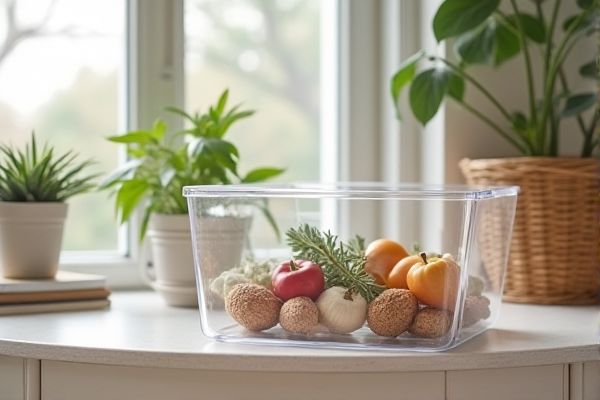
Acrylic bins offer a sleek, modern look with durability and easy maintenance, while wicker baskets provide a natural, rustic charm that adds warmth and texture to your space. Discover which storage option best suits your style and needs by reading the rest of the article.
Table of Comparison
| Feature | Acrylic Bin | Wicker Basket |
|---|---|---|
| Material | Transparent acrylic plastic | Natural woven fibers (rattan, willow) |
| Durability | High, shatter-resistant | Moderate, prone to wear |
| Weight | Lightweight | Light to medium weight |
| Maintenance | Easy to clean, water-resistant | Requires dry cleaning, can absorb moisture |
| Appearance | Modern, sleek, transparent | Rustic, natural, textured |
| Usage | Storage, display, organization | Storage, decoration, carrying items |
| Cost | Moderate to high | Low to moderate |
Introduction: Acrylic Bin vs Wicker Basket
Acrylic bins offer durability, transparency, and easy maintenance, making them ideal for modern storage solutions where visibility is key. Wicker baskets provide a natural, rustic aesthetic with breathable materials that help prevent moisture buildup in stored items. Choosing between acrylic bins and wicker baskets depends on the need for sturdiness and clarity versus organic style and air circulation.
Material Composition and Durability
Acrylic bins are made from a transparent plastic polymer known for its shatter-resistant and waterproof properties, making them highly durable and easy to clean for long-term use. Wicker baskets, crafted from natural materials such as rattan, willow, or bamboo, offer biodegradable and eco-friendly options but tend to be less durable, prone to wear, and susceptible to moisture damage over time. The choice between acrylic and wicker primarily depends on the need for sturdiness and maintenance versus aesthetic appeal and environmental sustainability.
Aesthetic Appeal and Design Options
Acrylic bins offer a sleek, modern aesthetic with clear or colored transparency that complements minimalist and contemporary interiors. Wicker baskets provide a natural, rustic charm with their woven textures and earthy tones, perfect for adding warmth and organic elements to your space. Your choice between acrylic bin and wicker basket depends on whether you prefer a clean, polished look or a cozy, handcrafted design.
Storage Capacity and Functionality
Acrylic bins typically offer larger storage capacity due to their rigid structure and stackable design, making them ideal for organizing bulky or heavy items. Wicker baskets provide flexible storage that adapts to irregular shapes but may lack uniform capacity and durability for heavy loads. Choosing between them depends on your need for maximizing space efficiency versus aesthetic appeal and lightweight portability.
Maintenance and Cleaning Requirements
Acrylic bins require minimal maintenance, as their smooth, non-porous surfaces can be easily wiped clean with a damp cloth or mild soap, making them resistant to stains and moisture. In contrast, wicker baskets need more careful cleaning, often requiring gentle vacuuming or spot cleaning with a soft brush to remove dust and dirt without damaging the woven fibers. Your choice depends on whether you prefer the low-maintenance durability of acrylic or the natural, textured aesthetic of wicker, which demands more attentive care.
Suitability for Different Spaces
Acrylic bins offer a sleek, modern look ideal for contemporary, minimalist spaces, providing transparency that helps easily identify contents, making them perfect for offices, bathrooms, and closets. Wicker baskets bring a natural, rustic charm suited for bohemian or farmhouse-style interiors, adding warmth and texture to living rooms, bedrooms, or entryways. Choosing between acrylic bins and wicker baskets depends on the desired aesthetic, durability needs, and the specific room's decor.
Environmental Impact and Sustainability
Acrylic bins are made from petroleum-based plastics, contributing to higher carbon emissions and limited biodegradability, which negatively impacts environmental sustainability. Wicker baskets, crafted from natural, renewable materials like rattan or willow, offer greater biodegradability and lower carbon footprints, making them a more eco-friendly storage option. Choosing wicker supports sustainable harvesting practices and reduces plastic waste in landfills and oceans.
Cost Comparison
Acrylic bins typically cost more upfront due to their durable, transparent material and sleek design, averaging between $15 to $50 depending on size and brand. Wicker baskets are generally more affordable, with prices ranging from $10 to $30, owing to their natural, handcrafted construction. Cost efficiency depends on longevity and aesthetic preferences; acrylic bins offer greater durability and modern appeal, while wicker baskets provide budget-friendly, rustic charm.
Versatility and Usage Scenarios
Acrylic bins offer superior versatility due to their transparent design, making them ideal for organizing office supplies, makeup, or pantry items while allowing easy content identification. Wicker baskets provide a natural, rustic aesthetic perfect for decorative storage in living rooms, laundry areas, or as gift hampers, adding texture and warmth to home decor. Both storage options cater to different usage scenarios, with acrylic bins excelling in modern, functional spaces and wicker baskets enhancing cozy, traditional environments.
Choosing the Best Option for Your Needs
Acrylic bins offer durability, clear visibility, and easy maintenance, making them ideal for modern organization and quick content identification. Wicker baskets provide a natural, aesthetic appeal with breathability and lightweight functionality, perfect for decorative storage and softer handling of items. Your decision depends on whether you prioritize durability and transparency or style and ventilation for your storage needs.
 homyna.com
homyna.com